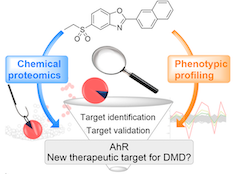News
2020
February

In February I was able to attended the 64th Biophysical Society Annual Meeting thanks to being awarded a Biophysical Society travel award. My abstract was selected to give a talk in the Ion Channels, Pharmacology and Disease Platform session about my PhD research looking at the gating mechanisms of the calcium-activated chloride channel TMEM16A, and the effect of anthracene-9-carboxylic acid. This gave me an excellent opportunity to discuss my work within the international biophysics community and gain valuable feedback along with being able to attend talks from a wide variety of sessions in the field and learn about the larger research community. I really enjoyed my time in San Diego at both the conference and exploring the city.
January

A collaboration between the Russell group (Chemistry and Pharmacology) and the Davies group (Physiology, Anatomy and Genetics) has identified, via a chemical proteomics and phenotypic profiling strategy, the arylhydrocarbon receptor (AhR) as the molecular target of ezutromid, the utrophin modulator that recently completed a Phase 2 clinical trial in Duchenne muscular dystrophy patients.
Ezutromid (formerly SMT C1100) was identified through phenotypic screening approach, and developed as a first-in-class utrophin modulator for the treatment of the severe muscle wasting disease Duchenne muscular dystrophy (DMD). The clinical trial showed promising efficacy and evidence of target engagement after 24 weeks of treatment, but these effects were not seen after the full 48 weeks of the trial. Without knowledge of the mechanism of action of ezutromid, it was difficult to rationalise the lack of sustained clinical efficacy, and development of ezutromid was discontinued.
In this work, we demonstrate through a series of target identification and validation studies that ezutromid binds to AhR with high affinity, and antagonism of AhR by ezutromid leads to utrophin upregulation, thereby confirming AhR as a viable target for utrophin functional replacement therapies. This work paves the way for the first target-based disease modifying drug discovery program in DMD.
https://onlinelibrary.wiley.com/doi/full/10.1002/anie.201912392